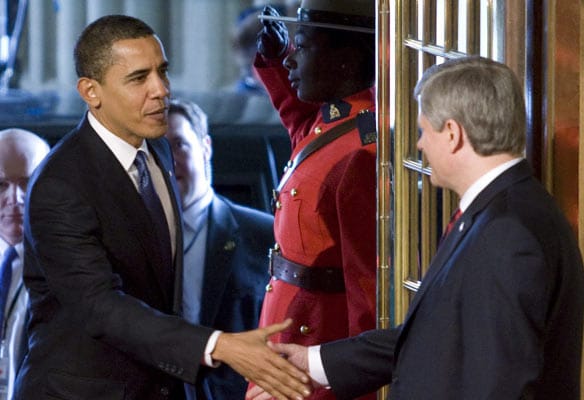Obama-mania hit Canada’s capital hard this week but there was much more at play than photo ops during the President’s five-hour visit.
Harper and Obama announced a “clean energy dialogue” focusing on “carbon capture and storage” technology (CCS) – a stash-the-emissions pipe-dream that remains unproven on an commercial scale anywhere in the world.
In particular, the myth that CCS will somehow eliminate emissions from the Alberta tar sands is a dangerous delusion. Just three months ago, a secret government memo came to light showing that significant carbon capture at the tar sands is virtually impossible.
“Only a small percentage of emitted CO2 is ‘capturable’ since most emissions aren’t pure enough,” federal experts concluded. “Only limited near-term opportunities exist in the oilsands and they largely relate to upgrader facilities.”
That of course has not stopped the Harper government and the oil lobby from trotting out this dubious technical fix as a rationale for the pell mell development of the dirtiest oil on Earth.
Last year Harper proclaimed “This new technology, carbon capture and storage, when fully commercialized … will collect carbon dioxide emissions from oilsands operations and coal-fired electrical plants and seal them deep underground.”
Strange. Mr. Harper was surely in possession of the memo in question when he made that bold statement. Perhaps he has expertise in geology and engineering surpassing those of the scientists in his employ.
This spin strategy goes far beyond mere words. The federal and Alberta government are shoveling $2.5 billion in tax dollars towards developing this supposed petroleum panacea – and the tar sands remains the number-one rationale for doing so.
Why the disconnect between science and policy? Harper and the oil industry have been sweating bullets that the incoming Obama Administration will begin to shift away from using filthy oil from Alberta.
The stakes are enormous since tar sands operators lack the infrastructure to deliver oil anywhere but the US.
This is also the largest capital project on the planet – and in Harper’s home province. More than $200 billion has been invested so far. Another $2.5 billion in public money towards a baseless technical solution is small potatoes if it will provide a rationale to keep the gravy train rolling a little while longer.
Bare in mind that CCS at the tar sands – even if it worked – would only deal with the emissions from extraction. The downstream emissions – predominantly from tailpipes – are four times as large. Unless drivers begin dragging very long hoses behind their vehicles, CCS will do nothing to deal with this much larger problem.
It is also useful to compare the $2.5 billion “investment” Harper and Alberta have made in CCS, to how much money the Canadian government is putting towards developing carbon-free technologies such as wind and solar: less than $1.5 billion.
In other words we are spending over one and a half times as much taxpayers dollars towards an unproven technology that will directly benefit the fossil fuel industry as we are developing truly carbon-neutral energy for the 21st century.
And then there is money. Since there are no commerical examples of CSS anywhere in the world, the costs remain highly uncertain. However the best estimates so far are that CSS would increase production costs by 30-60%. Who is going to pay for that? Given the plummeting economics of the tar sands, the likelihood of CCS being embraced by industry are becoming vanishingly small.
Back to Harper and Obama. The US president has his own dirty energy sector to placate: Big Coal. They have thrown $30 million towards a “clean coal” PR campaign in 2008 alone – much of it targeted directly at federal decision makers. If this is such a great idea, why do they need that much money to sell it?
The reason – bluntly put – is that is that “clean coal” is crap.
A Study from the Massachusetts Institute of Technology concluded that: “”the first commercial CCS plant won’t be on stream until 2030 at the earliest.” Even Oil-giant Shell “doesn’t foresee CCS being in widespread use until 2050.”
Unresolved challenges around geology, engineering and economics put this potential “solution” decades away – if ever. In the meantime, the tar sands and US coal plants may keep churning away towards atmospheric tipping points that scientists have been warning us about for years.
Details of the agreement today remain sketchy but a strong public endorsement of carbon capture by Obama and Harper – backed of course with more public money – would be a victory for the fossil fuel lobby and an setback on our road towards a green economy.
Subscribe to our newsletter
Stay up to date with DeSmog news and alerts






